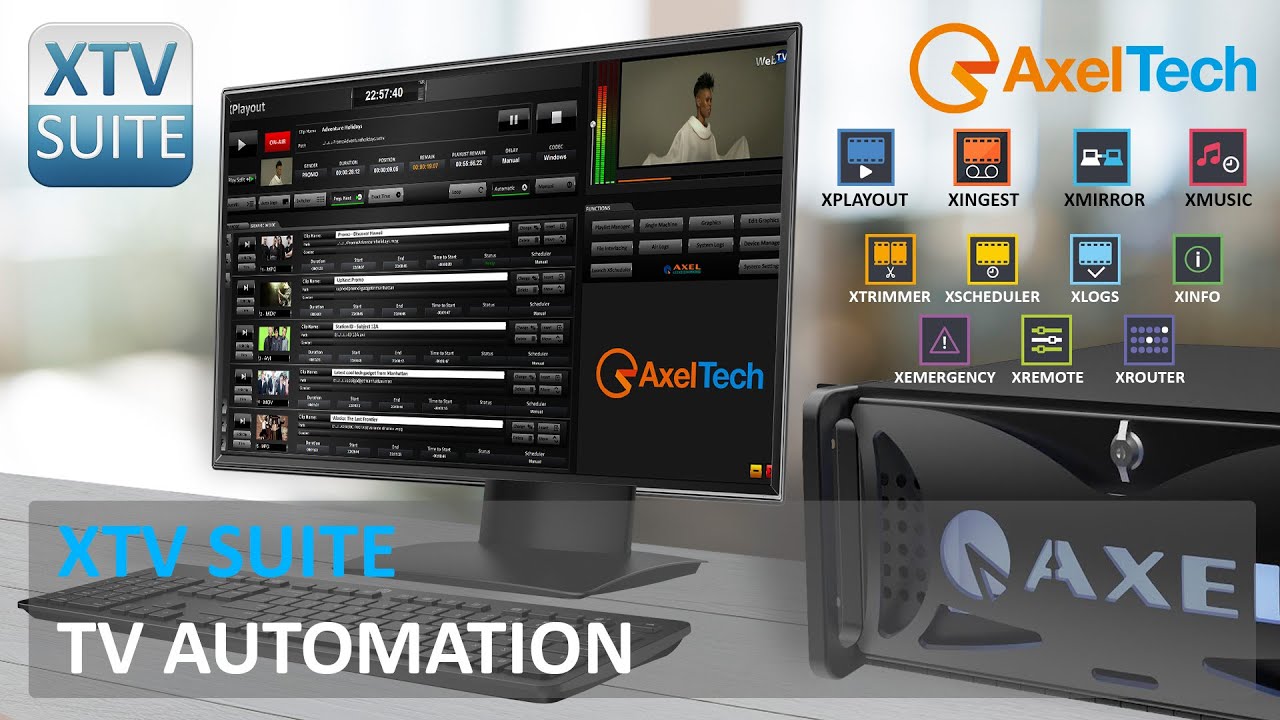Summary
From my years in broadcast tech, one of the most dependable tools I’ve used is XTV Suite. It’s more than just software; it’s an automation solution that truly transforms TV stations, Cable TV, and Web TV operations. With 24×7 unattended efficiency, it handles Playout, Capture, Trimming, and Scheduling without hiccups. The user-friendly interface is ideal not only for News Room or Satellite Channels, but even Corporate TV, CCTV, museums, and hotel pay TV channels. What makes it even more powerful is its Channel In A Box (CIAB) architecture, which ensures smooth scalability for any video wall or display system.
I remember deploying XTV for a Web TV project where handling simultaneous CG tasks became effortless. Thanks to support for SDI in HD, 4K, and 8K, and IP I/O protocols like NDI, SMPTE 2022, and SMPTE 2110, we didn’t have to worry about UDP, RTMP, HLS, or RTSP integration; it just worked. The XTV Cloud extension came as a relief, especially when switching to remote workflows. We tested it across various TV Playout facilities, and its automatic workflows and linear expansion always delivered solid results, particularly during high-pressure live broadcasts.
Flexible Versions & Modular Setup
The software versions are tailored for flexibility: whether you’re working with XTV Suite, XTV Compact, XPlayout, or XIngest, there’s a fit for your needs. I’ve personally used the Software+Hardware combos like XTV Compact and XIngest Compact, especially when a dedicated Ingest channel is essential. For smaller stations or rapid deployment, XPlayout Compact proves highly efficient. The modular approach allows full Playout and Ingest combinations, keeping everything synchronized and streamlined.
Redundancy & Broadcast Confidence
Another feature that stands out is XMirror, a nifty option we used for redundancy during a sports channel launch. It maintained a flawless broadcast loop, no matter the load. These setups aren’t just about technology; they represent confidence. Confidence that your video feeds, whether live or scheduled, will air without a glitch. So, if you’re seeking a robust, scalable, and smart TV automation system, XTV ticks all the boxes. From personal experience, it’s built for pros who don’t want to compromise on quality or control.
Broadcast System Powerhouse
When I first integrated the XTV Suite into our live studio pipeline, I realized how seamless true automation can be. It wasn’t just another Software installation. The System came fully preinstalled on a 1 RU Server compact, yet incredibly powerful. Built by Axel Technology, this professional suite was more than enough to manage Dual-Channel Playout and Ingest, and it offered precise control over GPIs, Serial Devices, and Switchers. With Scheduler, Trimmer, and Graphics tools, it brought efficiency to every aspect of our Broadcast environment. What stood out most was its 16TB Internal Storage, which handled everything without lag. The Support team and Tech Updates remained on point throughout our 1-Year license period.
Rugged Hardware, Trusted Performance
Inside that sleek RU chassis was a rock-solid Switchblade Systems build. Running on an Intel Xeon E-2478 8-core processor with 32GB RAM, a 1TB SSD, and additional hot-swap 3.5″ HDD bays, this beast never buckled. The NVIDIA T400 4GB GDDR6 video card gave flawless output, and with Blackmagic DeckLink Duo 2, we easily managed single-channel 3G-SDI ingest and playout. The Windows 10 Pro OS helped us tap into familiar tools, while RJ45, GbE, network ports, and a remote management port offered smooth connectivity and system management. Every component from storage to RAM was clearly selected for rugged reliability.
Smarter Features for Smarter Control
What made XTV truly exceptional were its Advanced automation abilities. Master Control helped us streamline operations, while features like playlist preview, cut/wait, and MarkOut let us get precise with editing. Subtitle rendering in multiple languages made our content more accessible, and compatibility with Smart TVs, smartphones, and tablets expanded our reach. Tools like hotkeys, numeric keyboard shortcuts, and remote monitoring gave operators real-time confidence. And whether using Cloud or online streaming, formats like H.264, H.265, ProRes, and DASH kept playback crisp. Tickers, rolls, and crawls worked smoothly through Automatic CG, while traffic scheduling, emergency playback, and program guide (EPG) enhanced our viewer experience.
Seamless Workflow & Monitoring
From RS422 SONY support to DIGICART and PROMATIC, external device switching was quick with GPI in/out and RS232. We used network protocols like IPv4 for reliable streaming, while running logs, system logs, and statistics gave deep insight into everything running. The automatic load of the last playlist on startup was a time-saver. We could also manage audio track files, loop transitions, and 2D squeezeback effects without compromise. Each preview, insertion, or adjustment felt responsive and intuitive, making the most of frame-accurate control tools and overall efficiency.
Editing Redefined with XTrimmer
The Axel XTrimmer changed the game for our editorial work. It allowed precise clip marking with in and out points, helped by real-time audio level correction and aspect ratio adjustments. We tested it using a Windows 10 i-7 computer connected to a 32” HDMI TV and Decklink Mini Monitor, ensuring our quality control stayed intact. With features like metadata insertion, even file rename, copy, or move didn’t disrupt embedded settings. Blackmagic and AJA devices were fully supported. We even integrated dynamic air graphics, smooth wipe transitions, and crossfade effects without touching the original file. The result? A clean on-air look, free of letterbox issues, exactly the broadcast standard we needed.


